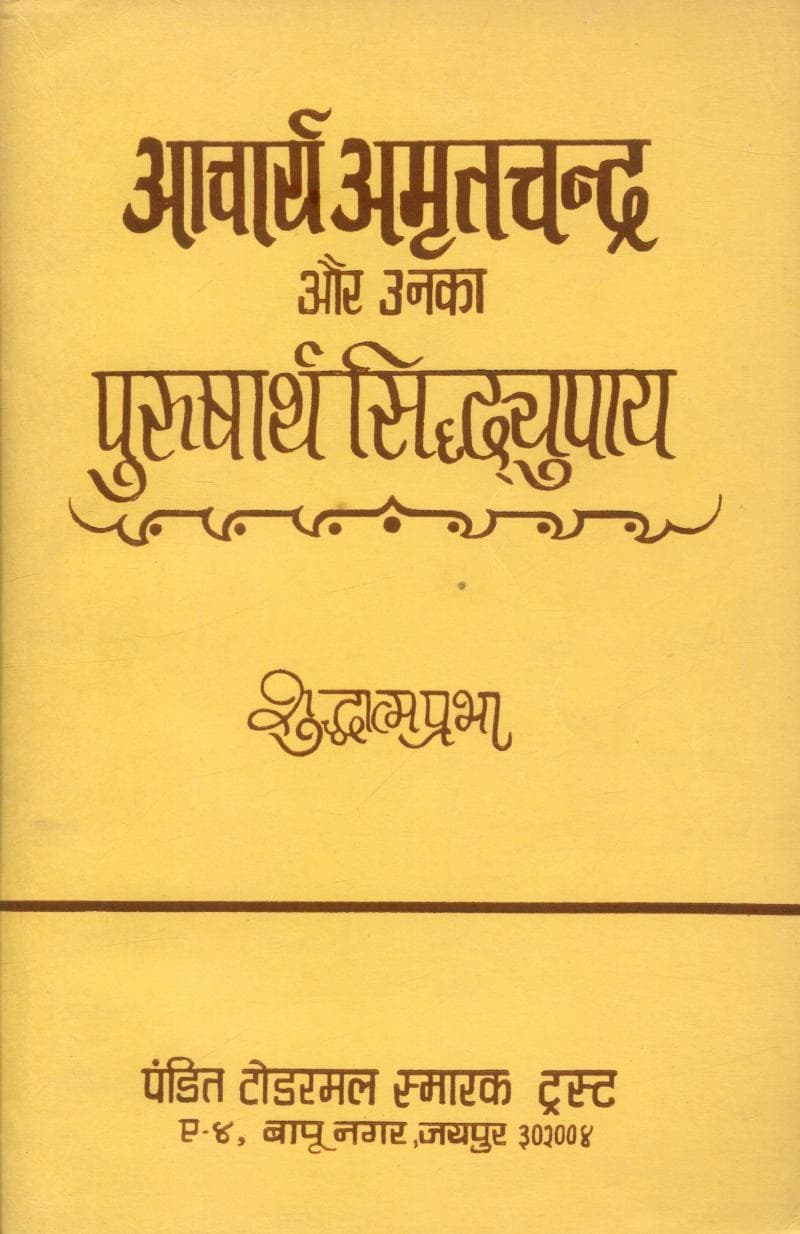Aacharya Amrutchandra Aur Unka Purusharth Siddhyupay
Added to library: September 1, 2025

Summary
Here is a comprehensive summary in English of the Jain text "Aacharya Amrutchandra aur Unka Purusharth Siddhyupay" by Shuddhatmaprabhashreeji, published by Pandit Todarmal Smarak Trust:
Book Title: Acharya Amritchandra and his Purushartha Siddhyupaya Author: Shuddhatmaprabhashreeji Publisher: Pandit Todarmal Smarak Trust
This book offers a deep and insightful exploration of the life, philosophy, and seminal work of Acharya Amritchandra, a highly revered Jain philosopher and scholar, with a particular focus on his profound treatise, the Purushartha Siddhyupaya. The author, Shuddhatmaprabhashreeji, meticulously analyzes the historical context and the philosophical underpinnings of Amritchandra's teachings, presenting them in a manner that is both scholarly and accessible.
Core Themes and Content:
The book can be broadly understood as having two major sections: the biography and intellectual legacy of Acharya Amritchandra, and a detailed exegesis of the Purushartha Siddhyupaya.
1. Acharya Amritchandra: Life, Times, and Influence
- Historical Context: The author situates Acharya Amritchandra within the rich philosophical and religious landscape of ancient India, specifically highlighting the Jain tradition and its intellectual developments during his era (likely around the 10th century CE).
- Biographical Details: While acknowledging the scarcity of definitive biographical details for many ancient Indian scholars, Shuddhatmaprabhashreeji synthesizes available information to present a picture of Amritchandra's life, his intellectual journey, and his role as a prominent teacher and commentator.
- Commentarial Tradition: A significant portion of the book focuses on Amritchandra's invaluable contributions to the Jain commentarial tradition. He is celebrated for his insightful commentaries on key Jain scriptures, particularly the works of Kundakunda, another immensely influential Jain philosopher. These commentaries were crucial for preserving, clarifying, and propagating the original teachings.
- Philosophical Stature: The author emphasizes Amritchandra's status as a master of Jain philosophy, particularly within the Digambara tradition. His ability to synthesize complex metaphysical concepts with practical ethical guidance is a recurring theme.
2. The Purushartha Siddhyupaya: A Comprehensive Analysis
The Purushartha Siddhyupaya (meaning "The Means to the Attainment of the Supreme Goal") is the central text discussed in the book. Shuddhatmaprabhashreeji dedicates a significant portion to dissecting its philosophical framework and practical applications.
- Meaning and Objective: The book explains that Purushartha Siddhyupaya is a comprehensive guide to achieving liberation (moksha), the ultimate aim of human existence in Jainism. It outlines the necessary spiritual discipline and understanding required for this endeavor.
- Key Philosophical Concepts:
- The Nature of the Self (Atman): A central theme is the exploration of the true nature of the soul as pure consciousness, inherently free and blissful, distinct from the physical body and karmic impurities.
- The Cycle of Birth and Death (Samsara): The book details the Jain understanding of samsara as a state of suffering caused by the accumulation of karma, which obscures the soul's true nature.
- Karma Siddhanta: The intricate doctrine of karma is explained, detailing how actions (karma) create bondage and influence future rebirths, and how the cessation of karmic influx leads to liberation.
- The Three Jewels (Triratna): Shuddhatmaprabhashreeji elaborates on the foundational principles of Right Faith (Samyak Darshan), Right Knowledge (Samyak Gyan), and Right Conduct (Samyak Charitra) as the essential path to liberation, as expounded in Purushartha Siddhyupaya.
- The Stages of Spiritual Progress (Gunasthana): The book outlines the progressive stages of spiritual development that a soul undergoes on its journey towards liberation.
- Ethical and Ascetic Practices: The text meticulously explains the practical aspects of the spiritual path, including ethical conduct, vows (vratas), austerities (tapas), meditation (dhyana), and the importance of non-violence (ahimsa) and self-control (samyama).
- Disputation of False Views: The Purushartha Siddhyupaya also addresses and refutes erroneous philosophical viewpoints that deviate from the Jain path to liberation, and the book highlights Amritchandra's skillful argumentation in this regard.
- Structure and Commentary: Shuddhatmaprabhashreeji likely provides a verse-by-verse explanation or thematic breakdown of the Purushartha Siddhyupaya, drawing upon various commentaries (including, perhaps, Amritchandra's own) to elucidate its meaning.
Author's Contribution (Shuddhatmaprabhashreeji):
Shuddhatmaprabhashreeji's work is characterized by its:
- Scholarly Depth: The author demonstrates a profound understanding of Jain philosophy and its textual traditions.
- Clarity and Accessibility: The complex philosophical concepts are presented in a lucid and understandable manner, making them accessible to a wider audience interested in Jainism.
- Devotional Tone: While scholarly, the book likely carries an underlying devotional reverence for Acharya Amritchandra and the teachings of Jainism.
- Preservation and Propagation: The book serves to preserve and propagate the invaluable teachings of Acharya Amritchandra and the Purushartha Siddhyupaya, contributing to the continued study and practice of Jainism.
In essence, "Acharya Amritchandra aur Unka Purushartha Siddhyupaya" by Shuddhatmaprabhashreeji is a significant scholarly work that serves as both a tribute to a pivotal Jain philosopher and a comprehensive guide to one of Jainism's most important texts, offering readers a deep understanding of the path to spiritual liberation.